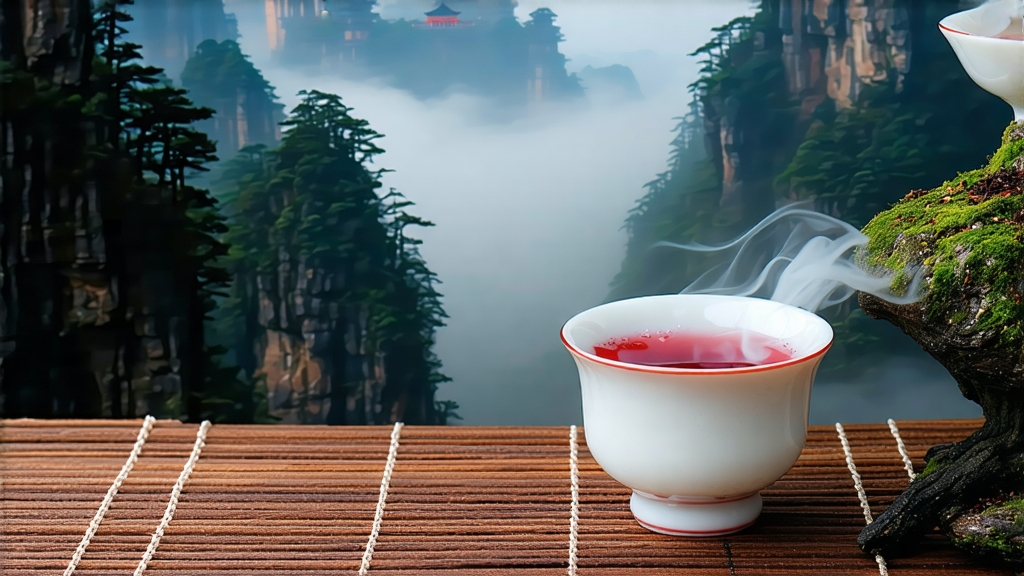
Long before English breakfast tables knew the word “black tea,” caravans loaded with dark, leathery leaves left the granite gorges of the Wuyi Mountains in northern Fujian. The year was 1646, Qing troops had just toppled the Ming, and retreating soldiers demanded fast-dried tea. Resourceful monks rushed the final wilting over fresh pinewood fires; the leaves absorbed the resinous smoke, travelled four months along the Min River to the port of Xiamen, and reached Amsterdam labeled “bohea.” Europe fell in love with the mysterious “smoky wine,” and Lapsang Souchong—literally “small sort from Lapu mountain”—became the first black tea ever exported, the ancestor of every subsequent congou, keemun, ceylon and assam.
Geography writes the first page of its story. The National Nature Reserve core zone, a UNESCO dual heritage site, rises from 200 m canyon rivers to 2,160 m mist-capped peaks within 30 km. Day-night temperature swings of 15 °C slow leaf growth, condensing amino acids; basaltic soils release manganese and potassium; 85 % humidity keeps the leaf supple. Only two tiny villages—Tongmu Guan and Miaowan—sit inside the strictly protected buffer, and every kilo of authentic Lapsang must carry a government trace-code linking back to one of 156 registered gardens.
The cultivar matters next. Most bushes are seed-propagated descendants of the original Wuyi Caicha, a medium-leaf, late-sprouting landrace that germinates only after the last mountain frost. Cuttings taken to India in 1848 by Robert Fortune failed above 1,000 m, proving that terroir, not genetics alone, creates the flavour. In spring, two leaves and a bud are plucked when the serrated edge turns parchment-white, indicating the ideal 3.2 % lignin content for withering.
Craftsmanship follows four centuries-old steps, each calibrated to relative humidity measured by the master’s forearm—when skin sticks to the leaf, the timing is right. 1. Sun-withering: bamboo trays are set on granite slabs for 45–60 min, turning every 10 min until the leaf loses 15 % weight and emits a faint cucumber note. 2. Indoor withering on pinewood racks: 4–5 h at 26 °C, 70 % RH; the leaf is gently tossed every 30 min to bruise the edge, initiating oxidation while the midrib stays green. 3. Rolling: traditionally by foot inside a 1.2 m diameter bamboo basket, 8 kg at a time, 12 min forward, 8 min backward, until cell breakage reaches 68 % without juice expression. 4. Smoking-drying: the signature act. A shallow pit is lined with moist pine slabs 3 cm thick; when they smoulder at 80 °C the leaves are spread on wire sieves 70 cm above, doors sealed, and the smoke recycled for 6–8 h until moisture drops to 4 %. The best grades receive a second cold-smoke the next morning, layering resin phenols onto the already cured leaf.
The result is not a monolith but a spectrum. Traditional Lapsang carries 2.8–4.1 mg/g guaiacol, giving a campfire nose that divides opinion; yet within Tongmu the same bushes yield an unsmoked “wild” version called Zheng Shan Xiao Zhong, dried over charcoal made from local oak. Between these poles lie half-smoked, fruit-dried, and even pine-needle variants, each stamped with the village seal and harvest date. International palates now favour the subtler styles: a 2021 competition in Hamburg awarded 96 points to a cold-smoke Lapsang that tasted of lychee and pipe tobacco, proving smoke need not eclipse terroir.
To brew, treat the leaf like a peated whisky—respect the smoke but chase the sweetness. Use 4 g for 120 ml, water at 90 °C, first infusion 8 s. A thin-walled porcelain gaiwan preserves clarity; the liquor glows amber-crimson, rimmed with jade green—the “golden circle” coveted by traders. Aroma moves through three acts: initial pine resin, mid-palate longan, finish of cooling sarsap